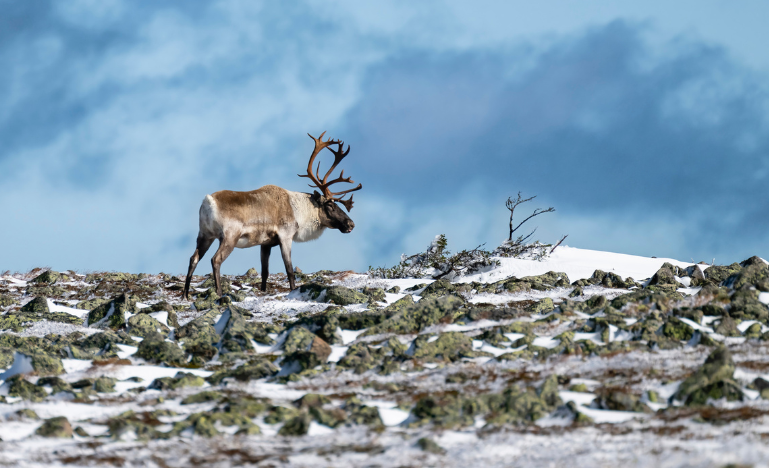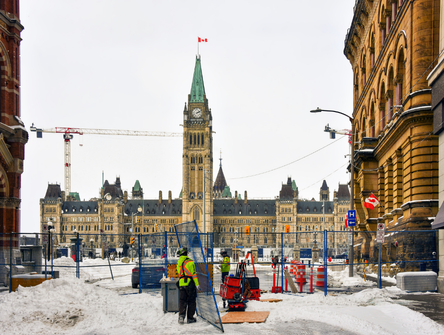At loggerheads over the fate of woodland caribou
Ottawa and Quebec are not seeing eye-to-eye — again. With the survival of the species at stake, the feds are flexing their muscles, and the province is far from happy about it

Woodland caribou, the iconic bellwether species that graces the Canadian quarter, are in peril.
The North American subspecies of reindeer is also at the center of a heated tussle between Ottawa and Quebec. It’s the third time in three years that a species at risk has been caught between two government orders, underscoring the strain between federal and provincial jurisdiction in environmental protection.
“It's a shame to see this kind of tension between the provincial and federal governments because everyone agrees that it's up to the provincial government to put in place sufficient measures to ensure adequate protection of biodiversity,” says Marc Bishai, a lawyer with the Quebec Environmental Law Center in Montreal.
The responsibility for managing land and wildlife in Canada is a tangled web of legal jurisdiction shared among the federal government, provinces, territories, municipalities and Indigenous peoples. The provinces and territories have primary responsibility within their borders, subject to Aboriginal rights.
The federal legislation governing species at risk is just as complex and convoluted. The Species at Risk Act (SARA) came into force in December 2012 and was intended to implement Canada’s obligations under the 1992 United Nations Convention on Biological Diversity, which was ratified by 196 states. It formally sets out a comprehensive framework to conserve biological diversity and protect wildlife species at risk of extinction and their habitat. SARA emphasizes the need to take proactive measures to protect species at risk. It compels the federal government to develop — in consultation with provinces and territories, wildlife management boards and Indigenous peoples — a recovery strategy for endangered and threatened species to help their populations rebound.
The legislation requires recovery strategies to be completed within one year of a species being listed as endangered or two years in the cases of species that are listed as threatened or extirpated.
But in practice, thanks to its “very cumbersome” mechanisms, as one judge put it, the application of federal SARA recovery plans hinges on the cooperation, discretion and goodwill of the various levels of government.
It can take many years after a species has been listed before concrete measures are taken to protect it, says Paule Halley, a Université Laval law professor and Canada Research Chair in Environmental Law. That’s because wildlife and habitat on provincial Crown land are deemed to be provincial property and under the legislative jurisdiction of the provinces.
The woodland caribou is a case in point. Boreal caribou have been listed as a “threatened” species under SARA since 2003 and as a “vulnerable” species since 2005 under Quebec’s Act Respecting Threatened or Vulnerable Species. In 2023, the Quebec government estimated the caribou population to be between 6,100 and 7,400 individual animals, representing about 15 per cent of Canada’s woodland caribou population.
According to the feds, the caribou population in Quebec and the rest of Canada is shrinking because of human-caused habitat loss. A 2023 Environment and Climate Change imminent threat assessment determined that the caribou populations in three Quebec regions have either crossed the threshold of quasi-extinction, are “very close” to reaching it, or could be extinct in about 10 years due to logging and road network expansions.
After calls for the province to adopt a comprehensive strategy to protect its woodland caribou ostensibly fell on deaf ears, this summer federal Environment Minister Steven Guilbeault initiated the process of making an emergency order under Section 80 of SARA in the province — a first without judicial intervention. If approved by the Governor in Council, the emergency order would prohibit activities that pose “imminent” threats faced by the three most-at-risk boreal caribou populations in Quebec.
“We're quite glad to see the action being taken in Quebec because unless there is a really comprehensive and coordinated plan to systematically protect that habitat, then it seems that it'll just continue to be chipped away at tree by tree, acre by acre until there's just nothing left for these animals to rely on,” says Joshua Ginsberg, director of the Ecojustice Environmental Law Clinic in Ottawa.
“That’s supposed to be the function of the national species at risk legislation — to provide that backstop to ensure that species don't face the dire threats that the caribou are now in.”
The ban would have a sizeable impact. According to provincial and industry officials, it would slash Quebec’s forestry potential by 1.4 million cubic metres of wood annually in the three zones where the emergency decree would be imposed and potentially lead to the loss of 6,500 jobs
“It's always possible to integrate different considerations into the measures we put in place to ensure we achieve a balance,” says Bishai.
“But there must come a point when we must be proactive in protecting biodiversity. That point has already come and may even have been passed by in the case of Quebec.”
The possible imposition of an emergency order has not been well-received by the Quebec government, which views the decree as unjustified and an intrusion into its jurisdiction.
“Let's not be fooled by those who say Quebec is doing nothing,” provincial Environment Minister Benoit Charette said in an open letter issued in late September.
“We are not spectators to the decline of the caribou.”
He says the province has invested nearly $100 million since 2019.
Several rulings examining the scope of SARA emergency orders have clarified that the federal legislation's purpose is “not at all” to directly encroach on provincial jurisdiction or impose uniform national standards. “The emergency decree can prohibit activities in a habitat but cannot manage the territories,” says Halley.
“So the federal government is not interfering in land management. Rather, it is using its criminal rights power, granted to it by the Constitution Act, 1867, to create prohibitions in provincial territory.”
Case law also holds that under Section 80, the federal minister must act and make a recommendation to the Governor in Council or the federal cabinet if they are of the opinion a species faces an imminent threat to its survival or recovery.
This summer, Federal Court Justice Yvan Roy castigated Guilbeault for violating SARA by waiting eight months to recommend an emergency order to protect the spotted owl. Only one is believed to exist in British Columbia’s southwestern old-growth forests.
That’s nothing new, says Shaun Fluker, a University of Calgary environmental law professor.
“The courts have consistently held the minister to a strict high standard on forming that opinion and forcing the minister to base his or her decision on science,” he says.
“That is a clear trend in case law.”
However, it is unclear whether the courts will apply those same exacting standards to force the federal cabinet to issue an emergency protection order when it does not want to. The problem, Fluker notes, is that SARA gives the Governor in Council full discretion to make such decisions.
What is certain is that the federal government is extremely reluctant to make emergency orders. There have only been two since the legislation came into force, both of which were issued after the courts compelled the federal government to reconsider its position. That's not really surprising, say environmental legal experts. The federal government has resorted to using the emergency order as leverage to induce provincial governments to take their own species protection measures.
“It’s legitimate for the federal government to warn a province that it is thinking of making an order, but it has to follow up very quickly,” Ginsberg says.
“That can be an effective tactic because an emergency order is supposed to be a last resort, and only if there are dire threats.”
Fluker suspects the federal government is trying to press the Quebec government to sign a SARA conservation agreement. These accords may include a series of measures, including monitoring the status of the species and protecting the species’ habitat.
In pacts dealing with woodland caribou, the federal government has provided monies, and in exchange, the provinces have committed to implement protection and recovery measures usually set out in the agreement’s schedule. At least seven caribou conservation agreements have been reached between the federal government and provinces. In September, Guilbeault invited his Quebec counterpart to the negotiating table, underlining that the province could benefit from hundreds of millions of dollars in funding to protect biodiversity. But Quebec, it seems, is not interested.
Critics say the problem is many of these conservation agreements fall way short.
“They have the potential to be an effective tool, but in practice, most have been little more than agreements to delay action,” says Ginsberg.
Fluker says some voluntary conservation agreements, such as the deals struck with the Yukon and Northwest Territories, provide “real protection,” but others are “not worth what’s written in them.”
A 2023 report issued by the Environment and Sustainable Development Commissioner Jerry DeMarco recommended that Environment Canada work with its “partners to strengthen conservation agreements.” The report said they should include milestones, measurable targets, clear accountability measures, and sufficient information to track and assess meaningful progress and results.
Ottawa may succeed at forcing Quebec’s hand to finally implement a comprehensive strategy that will protect woodland caribou. But Fluker says it is illusory to believe that SARA has actually succeeded in protecting critical habitat beyond what would already be available under protected area or wildlife legislation.
“SARA has significant limitations in terms of what it can achieve, and you can see that,” he says.
“Species loss is accelerating in Canada. But SARA has at least systematized legally accountable moments where state authorities can be held accountable. But when it comes to habitat protection, the Act itself is full of holes and relies almost entirely on the exercise of discretion by federal officials.”
Halley has a different take. She says SARA is far from perfect and is unfortunately tainted by a political process involved in listing species at risk and protecting critical habitat on provincial and territorial lands. But its provisions at least delineate what is reasonable, which facilitates judicial review of decisions.
“It’s a good start to set the record straight,” says Halley, who hopes that public authorities will eventually draw up “ambitious” laws and regulations to protect endangered species.


